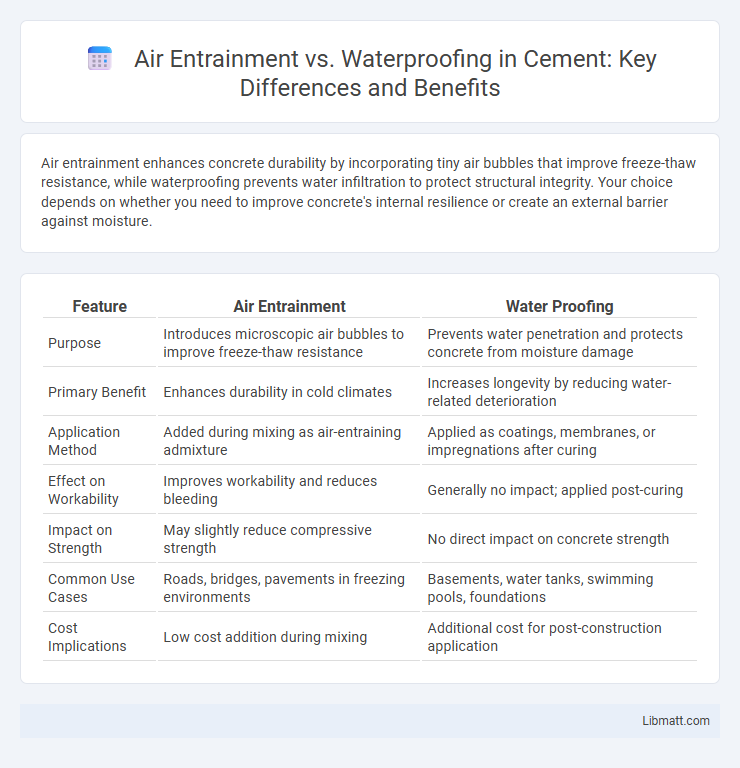Air entrainment enhances concrete durability by incorporating tiny air bubbles that improve freeze-thaw resistance, while waterproofing prevents water infiltration to protect structural integrity. Your choice depends on whether you need to improve concrete's internal resilience or create an external barrier against moisture.
Table of Comparison
| Feature | Air Entrainment | Water Proofing |
|---|---|---|
| Purpose | Introduces microscopic air bubbles to improve freeze-thaw resistance | Prevents water penetration and protects concrete from moisture damage |
| Primary Benefit | Enhances durability in cold climates | Increases longevity by reducing water-related deterioration |
| Application Method | Added during mixing as air-entraining admixture | Applied as coatings, membranes, or impregnations after curing |
| Effect on Workability | Improves workability and reduces bleeding | Generally no impact; applied post-curing |
| Impact on Strength | May slightly reduce compressive strength | No direct impact on concrete strength |
| Common Use Cases | Roads, bridges, pavements in freezing environments | Basements, water tanks, swimming pools, foundations |
| Cost Implications | Low cost addition during mixing | Additional cost for post-construction application |
Introduction to Air Entrainment and Waterproofing
Air entrainment involves deliberately incorporating tiny air bubbles into concrete to enhance its durability and resistance to freeze-thaw cycles, improving overall structural performance. Waterproofing refers to the application of materials and techniques designed to prevent water penetration and protect structures from moisture damage. Both methods are critical in construction, with air entrainment targeting internal concrete quality while waterproofing focuses on external moisture protection.
Defining Air Entrainment in Concrete
Air entrainment in concrete involves deliberately incorporating microscopic air bubbles into the mixture to improve durability and freeze-thaw resistance. These tiny air voids act as pressure relief channels, preventing internal cracking caused by expanding water during freezing. In contrast, waterproofing aims to prevent water ingress on concrete surfaces, focusing on moisture barrier properties rather than modifying the internal pore structure.
What is Waterproofing in Construction?
Waterproofing in construction is the process of making structures impervious to water infiltration, protecting buildings from moisture damage and enhancing durability. It involves applying specialized materials like membranes, coatings, or sealants to roofs, basements, and foundations to prevent water penetration. Your project's success depends on effective waterproofing, which differs from air entrainment that primarily improves concrete's freeze-thaw resistance by incorporating microscopic air bubbles.
Key Differences Between Air Entrainment and Waterproofing
Air entrainment involves introducing microscopic air bubbles into concrete to improve durability and resistance to freeze-thaw cycles, while waterproofing focuses on preventing water penetration through materials or surfaces. Air entrainment enhances concrete's internal structure to reduce cracking from moisture expansion, whereas waterproofing applies external barriers or coatings to block water ingress. Understanding these key differences helps you select the right method for structural longevity and water damage prevention.
Benefits of Air Entrainment in Concrete Structures
Air entrainment in concrete significantly enhances its durability by introducing microscopic air bubbles that improve resistance to freeze-thaw cycles, reducing cracking and scaling. This technique also increases the workability of concrete, making it easier to place and finish without compromising compressive strength. While waterproofing primarily prevents water ingress, air entrainment contributes to concrete longevity by mitigating internal damage caused by moisture expansion and contraction.
Advantages of Waterproofing Techniques
Waterproofing techniques provide superior protection against moisture penetration, preventing structural damage and mold growth in buildings. These methods enhance durability by creating barriers that resist water ingress, ensuring long-term integrity of foundations, walls, and roofs. Effective waterproofing also improves indoor air quality by eliminating damp conditions that promote allergen proliferation.
Applications: When to Use Air Entrainment vs Waterproofing
Air entrainment is essential in concrete applications exposed to freeze-thaw cycles, such as sidewalks, driveways, and bridges, where microscopic air bubbles improve durability and reduce cracking. Waterproofing is crucial for structures like basements, foundations, and water tanks that require protection against water infiltration and moisture damage. Your choice depends on whether you need enhanced freeze-thaw resistance (air entrainment) or a barrier against water penetration (waterproofing).
Factors Influencing Choice Between Air Entrainment and Waterproofing
The choice between air entrainment and waterproofing in concrete depends primarily on environmental exposure and desired durability, with air entrainment enhancing freeze-thaw resistance through controlled microscopic air bubbles, while waterproofing provides a physical barrier against water infiltration. Key factors influencing this choice include climatic conditions, water exposure intensity, and structural requirements, where air entrainment is preferred in cold climates prone to freezing cycles, and waterproofing is essential for preventing moisture penetration in foundations and below-grade structures. Material compatibility, cost considerations, and long-term maintenance also play significant roles in determining the optimal approach to protecting concrete from water-related damage.
Common Misconceptions and Mistakes
Air entrainment and waterproofing are often confused, but air entrainment involves introducing tiny air bubbles into concrete to improve freeze-thaw resistance, while waterproofing focuses on preventing water ingress. A common misconception is that air entrainment alone provides waterproofing, leading to mistakes where waterproof membranes or sealants are neglected. Ensure your construction plans separately address both air entrainment for durability and dedicated waterproofing methods for effective moisture protection.
Conclusion: Selecting the Right Solution for Durability
Air entrainment enhances concrete durability by introducing microscopic air bubbles, improving freeze-thaw resistance and reducing surface scaling, while waterproofing creates a barrier that prevents water infiltration and protects structural integrity. Choosing the right solution depends on environmental exposure and project requirements; air entrainment is ideal for freeze-thaw conditions, whereas waterproofing is essential for preventing moisture damage in submerged or high-humidity environments. Combining both methods can maximize longevity and durability in demanding construction applications.
Air entrainment vs Water proofing Infographic

 libmatt.com
libmatt.com